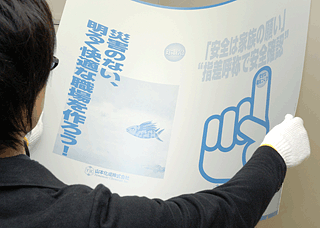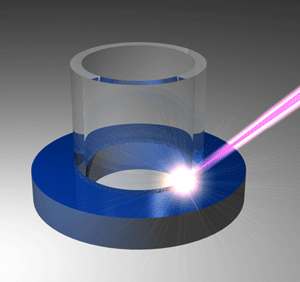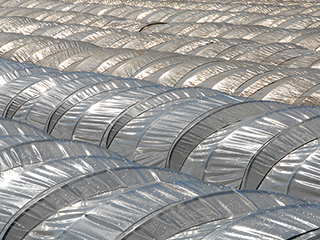Examples of Application
Example 1
[Thermal and pressure-sensitive dyes]
Leuco dye, which develops color when it comes into contact with acid, is used.
With pressure-sensitive paper, capsules containing dye and a paper coated with a developer are layered. When pressure is applied, the capsules rupture, causing the dye and developer to come into contact with one another and produce color.
With thermal paper, the dye and developer, etc. are dispersed in polyvinyl alcohol, a binding agent, and coated on the paper. When heat is applied, the dye and developer melt and mix, producing color



Example 2
[Dyes for heat- sensitive materials]
Thermo-indicating materials, which change color based on heat by using a reversible reaction between a leuco dye and developer, are made up of a dye, developer, and a material that controls the production of color (an alcohol-based binding agent). As these materials reversibly change color based on predetermined temperature ranges, they are used to indicate proper temperature in foods and beverages, or to change the color of toys and other items.
Example of a dye for thermo-indicating material in use Functional Dye Manufacturer Yamamoto ChemicalsDyes for thermo-indicating materials use a reversible reaction between a dye and a developer. For this reason, the material reverts back to red as the temperature shifts from body temperature to room temperature.
Example 3
[Transparent heat-sensitive dyes for medical use]
An image is formed through a heat-induced color reaction between the leuco dye and a developer. High gradation is achieved by selecting multiple dyes and binder resins. Additionally, by adjusting the amount of binder and grain size of the developer, the dye can be dissolved to obtain transparency. Our dyes are used for this purpose.

Example 4 [Sublimation dyes]
The sublimation transfer printing method prints images by melting a thermal transfer ink ribbon with a heated head, and sublimating the dye.
This method offers superior density gradation compared with conventional inkjet printing methods, making it possible to output full color images with high image quality comparable to silver halide photography.
Our sublimation dyes can be used with the sublimation transfer printing method.
We can provide thermal transfer ink ribbons that can produce full-color images boasting excellent clarity and robustness, and outstanding color density and light stability in particular.
<Examples of Sublimation Dyes Usage(Comparative Image)>


Example 5
[Photo-thermal conversion dyes for CTP]
In the printing plate making process, the process of outputting a direct printing plate from data such as an image that has been electronically processed and accumulated by a computer is referred to as "computer to plate," abbreviated as "CTP." CTP systems are expected to offer drastic optimizations including resource and labor savings by omitting the film process, and in recent years the types of plate materials have increased, expanding the range of choices available.
The plate materials for CTP can be broadly divided into two categories: the optical mode type which works with visible light lasers, and the thermal mode type which works with infrared lasers.
The materials for CTP supplied by Yamamoto Chemicals are photo-sensitive dyes for CTP original plate making that effectively absorb light emitted by an exposing light source.

Example 6
[LCD dichroic dyes]
Product consigned by Mitsui Fine Chemicals, Inc.Liquid crystal displays (LCDs) do not emit light themselves like conventional CRT displays; these displays utilize light transmission and are used in various fields.
Dyes from Yamamoto Chemicals offer outstanding solubility in liquid crystal, contrast (ratio) and clarity. They are widely used in LCD panels, automotive instrument panels and other applications.

Example 7
[Dyes for laser welding]
Laser-based resin welding is a method where two resin objects to be welded are placed into contact with one another, and then bonded to one another by melting their contacted surfaces with a laser beam.
Unlike conventional colorants, laser light-absorbing colorants from Yamamoto Chemicals become colorless after laser irradiation.
This allows laser welding to be visually confirmed, making it an effective resin laser welding agent.

Example 8
[Dyes for agricultural films]
Heat-shielding film can be used to absorb heat rays from sunlight to control increases in plant and soil temperatures. When cultivating crops in summer, the use of this heat-shielding film can prevent crop damage from high temperatures, improve germination rates, prevent the formation of leggy seedlings, and provide labor savings by reducing irrigation frequency. It is also expected to promote growth and increase yield by improving growing conditions. (Used as film for plastic greenhouses, etc.)
Additionally, the growth of plants is influenced by a plant hormone known as phytochrome through a photomorphogenic response. There are two types of phytochrome, Pr and Pfr. When light is reduced around the 660 nm wavelength, plants are more influenced by Pr type and grow taller. Conversely, when light is reduced around the 730 nm wavelength, plants are more influenced by the Pfr type and experience stunted growth.
By controlling these wavelengths of light with dye filters, it is possible to control the growth of plants.
Yamamoto Chemicals' YKR series of near-infrared resonance photosensitive dyes are used for these dye filters.

Example 9
[Dyes for illumination sensors]
The wavelength sensitivity of semiconductor photodetector elements used in the light-receiving components of illumination sensors peaks in the infrared region, which is a longer wavelength than visible light. For this reason, they can detect near-infrared light that is not visible to the human eye and mistakenly determine a scene to be bright. Using a dye filter that cuts near-infrared light provides these illumination sensors with characteristics that are similar to visible light sensitivity.
Yamamoto Chemicals' YKR series of near-infrared resonance photosensitive dyes are used for these dye filters.

Example 10
[Dyes for flash fusing toners]
Traditionally, the heat roll method was used as an image fixation technique for electrophotography, but in this case, there is a decrease in resolution associated with image changes caused by thermocompression bonding, or there are restrictions on the types of materials that can be printed on.
So-called flash fusing toner fusing, which involves fusing and fixing through a xenon lamp using near-infrared resonance photosensitive material as a photo-thermal conversation agent, does not produce these issues because it is non-contact. Near-infrared resonance photosensitive agents require high visual transmittance, considering their stability in toner and impact on image hue.
(These toners are used in products such as large high-speed printers)

Examples of the application of dyes for polarizing film
Examples of Application (Polarized Lens)
Incorporating a polarizing film into the lens of the eyeglasses imparts the lenses with the function of cutting reflected light.
As the photo below shows, polarized lenses that incorporate polarizing film make the fish in a pond clearly visible by cutting reflected light.

Fibers containing polarizing dye
Functional fiber incorporating polarizing dye to produce polarizing performance (courtesy Tokyo Kasei University)
Conventionally, polarizing dyes used for film are applied to fibers to develop fibers that have polarizing performance.
The intensity of color and how it appears change depending on how the fibers are woven and the angle of overlap.
We offer a lineup of various colors, including the four primary colors.
Examples of the application of Specific Wavelength Absorption Dyes
Soluble black IR-transmitting dye in PP
Example of a PP resin that shields the visible light range and appears black, but can transmit light in the IR range.Courtesy Prime Polymer Co., Ltd.
This is an example of a near-infrared resonance photosensitive dye being used for wavelength control.


Near-infrared resonance photosensitive fibers
Functional fibers with near-infrared resonance photosensitive dyes weaved in (courtesy Tokyo Kasei University)
By having the capacity to absorb near-infrared light and overlaying colored fibers on the near-infrared resonance photosensitive fibers, patterns embroidered with the near-infrared resonance photosensitive fibers can be seen with an IR camera, even though they are difficult to see with the naked eye.
This allows patterns such as logos and QR codes to be added without compromising the design of a fabric.
It is expected that the use of this technology will spread to various applications including counterfeit/replica prevention and traceability.

Examples of the application of leuco dyes
UV curing and coloring adhesives
Use as an adhesive where adhesion and coloration proceed simultaneously with UV irradiation (courtesy Mitsui Chemicals)
In its uncured state, it is colorless and transparent, but when exposed to UV radiation and cured, it not only exhibits adhesive properties but also changes color from colorless to black (becomes colored) adhesive.
Depending on the dye used, the material can turn black or into many other colors.
Absorption wavelengths can also be controlled, showing high transparency in the IR region.


Absorption wavelengths can also be controlled, showing high transparency in the IR region

Contact Us
For consultations or queries regarding
Yamamoto Chemicals and its products,
feel free to contact us via telephone
or the email inquiry form.
Telephone queries: [Tokyo Office]
+81-3-6402-2191Weekdays 9:00 a.m. to 5:00 p.m.,
closed Saturdays, Sundays and public holidays


